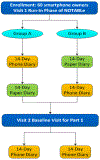Performance, acceptability, and validation of a phone application bowel diary
- PMID: 32960998
- PMCID: PMC7680657
- DOI: 10.1002/nau.24520
Performance, acceptability, and validation of a phone application bowel diary
Abstract
Aims: To assess performance, acceptability, external validity, and reliability of a phone application electronic bowel diary (PFDN Bowel eDiary).
Methods: Women reporting refractory accidental bowel leakage (ABL) were enrolled in a randomized, crossover trial evaluating paper versus eDiary documentation of bowel movements (BM) and fecal incontinence episodes (FIE). Events were characterized by the presence or absence of urgency and Bristol stool scale consistency. The eDiary entries were date/time stamped and prompted by twice-daily phone notifications. Women were randomized to complete up to three consecutive 14-day diaries in two sequences. Diary events were compared between formats using the Pearson correlation. System usability scale (SUS) assessed eDiary usability. The eDiary test-retest reliability was assessed with intraclass correlations (ICCs).
Results: Paired diary data were available from 60/69 (87%) women 63.8 ± 9.8 years old with mean 13.2 BM per week and 6.5 FIE per week (nearly half with urgency). Among those providing diaries, adherence did not differ by paper or eDiary (93.3% vs. 95.0%). Notifications prompted 29.6% of eDiary entries, improving adherence from 70% to 95%. Paper and eDiaries were moderate to-strongly correlated for BMs per week (r = .61), urgency BMs per week (r = .76), FIE per week (r = .66), urgency FIE per week (r = .72). Test-retest reliability was good (ICC = .81 BMs per week, .79 urgency BMs per week, .74 FIE per week, and .62 urgency FIE per week). The mean SUS score was high, 82.3 ± 17.5 (range, 0-100) with 91.4% rating it easy to use, and 75.9% preferring the eDiary over paper.
Conclusion: The PFDN Bowel eDiary correlated well with paper diary was considered easy to use, preferred to paper diaries, had high rates of confirmed real-time diary completion that obviated staff data entry.
Keywords: Bowel eDiary; accidental bowel leakage; electronic bowel diary; fecal incontinence; phone application diary.
© 2020 Wiley Periodicals LLC.
Figures
References
-
- Nelson R, Norton N, Cautley E, Furner S. Community-based prevalence of anal incontinence. JAMA. 1995;274:559–61. - PubMed
-
- Bharucha AE, Zinsmeister AR, Locke GR, Seide BM, McKeon K, Schleck CD, et al. Prevalence and burden of fecal incontinence: a population-based study in women. Gastroenterology. 2005;129:42–9. - PubMed
-
- Melville JL, Fan MY, Newton K, Fenner D. Fecal incontinence in US women: a population-based study. Am J Obstet Gynecol. 2005;193:2071–6. - PubMed
-
- Brown HW, Wexner SD, Segall MM, Brezoczky KL, Lukacz ES. Accidental bowel leakage in the mature women's health study: prevalence and predictors. Int J Clin Pract. 2012;66:1101–8. - PubMed
-
- Dey AN. Characteristics of elderly nursing home residents: data from the 1995 National Nursing Home Survey. Adv Data. 1997;289:1–8. - PubMed
Publication types
MeSH terms
Grants and funding
LinkOut - more resources
Full Text Sources
Medical
Molecular Biology Databases
Miscellaneous




